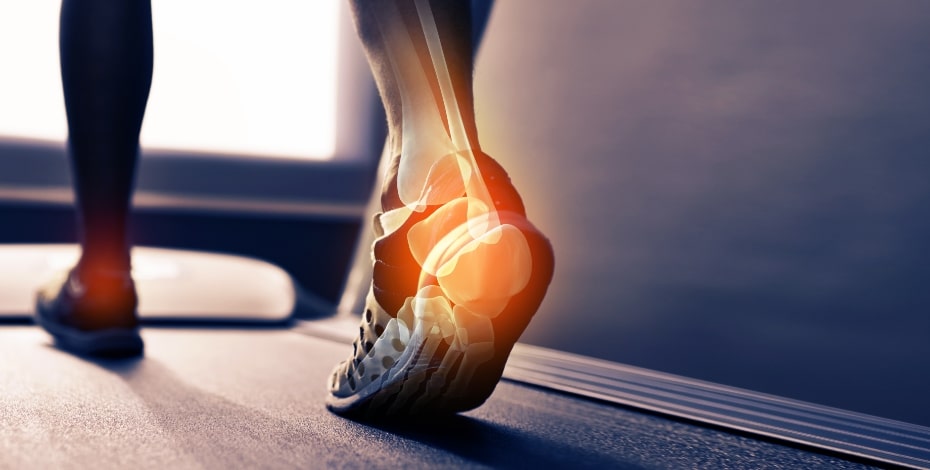
Making sense of plantar heel pain

RESEARCH FOCUS A recently completed study on chronic plantar heel pain has revealed that the causes are far from straightforward.
Chronic plantar heel pain (CPHP) is the most common reason why people with musculoskeletal foot pain consult a healthcare practitioner and it encompasses a range of conditions, including plantar fasciitis.
The clinical causes underlying CPHP, however, are not well understood.
New research is now starting to shed some light on risk factors and causes of heel pain, suggesting better, evidence-based approaches to treatment.
‘The foot is often considered in a separate light by physiotherapists,’ says Dr Jason Rogers, an APA Musculoskeletal Physiotherapist and a postdoctoral researcher at the Menzies Institute for Medical Research in Tasmania.
‘We don’t seem to take the same approach to pain and tendon-like structures in the foot as we do in other areas.’
It’s complicated further by the fact that, for foot pain, physiotherapists are generally not the first port of call.
'The majority of patients will visit a podiatrist. However, says Jason, a physiotherapist can bring their knowledge of other chronic musculoskeletal conditions to the table.'
Jason has recently completed a series of studies describing different heel pain phenotypes, risk factors and predictors of outcomes, including the important role of psychological, pain processing and bone imaging factors in CPHP.
The project has been funded in part by a Physiotherapy Research Foundation Seeding Grant of $10,000 awarded in 2014 as well as other grants from organisations including Arthritis Australia, the Rebecca L Cooper Medical Research Foundation and the Royal Hobart Hospital Research Foundation.
The first study, a case-control investigation, assessed 220 participants with heel pain and compared them to 100 age- and sex-matched population-based controls across a range of factors, including activity level, foot and ankle function, psychological variables and adiposity-based measures such as waist girth and body fat composition, which are known risk factors in other areas for chronic musculoskeletal pain.
Imaging tools including MRI, ultrasound and high-resolution peripheral quantitative computed tomography were used to look at the foot structure.
‘We wanted to know about the risk factors and what we could do in the clinic to identify different subgroups of people with heel pain and we also wanted to know what was going on in the foot directly,’ Jason says.
The results, he says, were interesting.
On the clinical side of the study, most of the risk factors were not foot-related. Instead, they included pain catastrophising, the presence of multi-site pain, being overweight (as measured by waist girth) and the strength of the plantar flexors as well as neuropathic symptoms.
A longitudinal study following up patients one year later confirmed that the same risk factors stood out.
‘Of all of those risk factors, none of them directly measures a foot-related factor,’ Jason says.
‘Symptomatic factors and factors external to the foot seem to be the most strongly associated with having heel pain.’
On the imaging side, findings indicated that differences between cases and controls in plantar fascia thickness and the signal within the fascia, were associated with foot pain.
There was also a new finding—50 per cent of cases showed evidence of a bone marrow lesion (BML) in the heel bone and the presence and size of a BML was associated with the risk of having heel pain.
In contrast, fat pad signal and bone spurs did not seem to be independently associated with heel pain.
‘It’s not only about the fascia; there are changes that happen on the bone side,’ says Jason.
‘A BML on MRI is a measure of physiological stress but it’s yet to be determined exactly what the nature of that stress is—is it mostly load through the heel or are there systemic associations such as with adiposity?’
Jason says the results show that there are important subgroups of heel pain that can inform the types of interventions used to treat the condition, rather than just trying one treatment and then another.
‘This is about recognising different subgroups or phenotypes of heel pain.
'If you can identify those, then you can target treatments according to the dominant impairment.
'The fundamental theme of this research is getting a better understanding of the different drivers of pain that warrant different interventions,’ he says.
The next step, says Jason, is to start testing different approaches to treatment tailored to the specific subgroups of heel pain.
These include the pain mechanism phenotypes, further divided between locally generated, neuropathic or centrally generated pain; anatomical phenotypes, including plantar fascia versus BML versus other structural issues; and metabolic phenotypes comprising people with high levels of adiposity.
‘I plan to do a number of controlled trials applying treatment specific to those subgroups to see if we can demonstrate that it leads to superior outcomes compared to a usual care approach,’ he says.
For example, Jason says, extracorporeal shockwave therapy is helpful in reducing signs of bone swelling but has been used to treat heel pain with ambiguous results.
'By using it specifically on patients with a BML, he hopes that improved outcomes might be seen.
On the other hand, patients who show signs of pain catastrophising might benefit more from a psychologically informed approach to reduce their movement fear than from ‘mechanically’ focused musculoskeletal approaches.
‘If you come in and you score highly on the pain catastrophising scale, I would say, “If that’s the dominant impairment, let’s focus our energies on dealing specifically with that impairment”.
'That could be novel because it might involve treating foot pain by not necessarily doing much directly with the foot itself,’ Jason explains.
‘You do want tissues to be conditioned and loaded in the longer term but in the case of a sensitised foot, it’s a process of doing it in a sequential and graded manner so as not to drive further fear.’
Jason is sharing his database of results, which he says is arguably the largest case-control and longitudinal study available, with other groups, including those conducting the foot and ankle research program at La Trobe University’s Sport and Exercise Medicine Research Centre.
Ultimately, he says, he wants to make clinical sense of his findings, gain an understanding of what can go wrong to cause CPHP and develop evidence-based interventions and treatments for the different subgroups.
‘These results are not necessarily about people walking in off the street with recent onset heel pain.
'These results and this approach are about helping people who have chronic unresponsive heel pain; it’s about identifying the dominant themes at play and then aligning resources and targeting care based on those dominant themes.
'I think it’s an approach every physio would take; it’s just a matter of trying to make sense of it in the foot.’
Click here for an infographic based on Jason’s research.
© Copyright 2025 by Australian Physiotherapy Association. All rights reserved.





